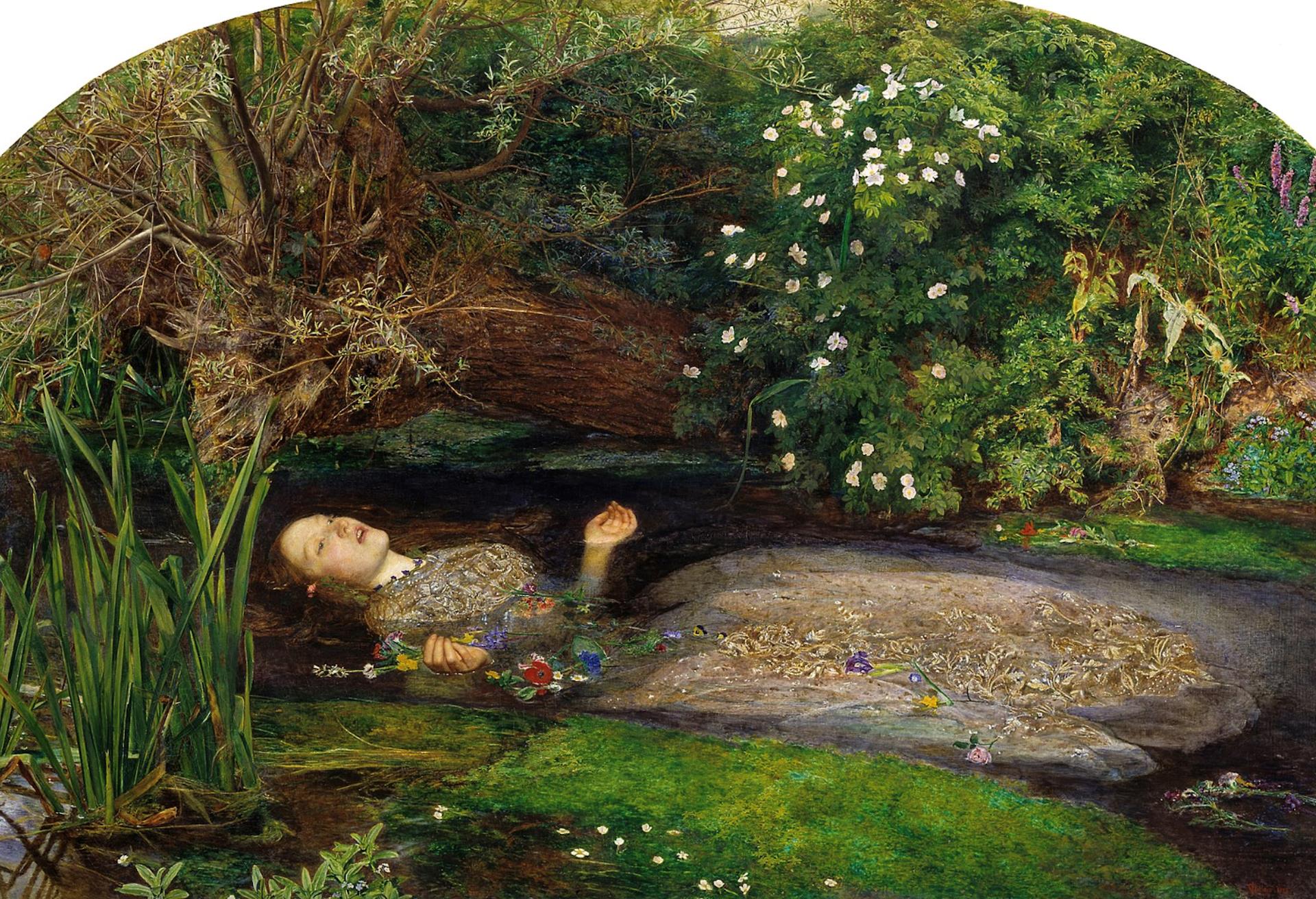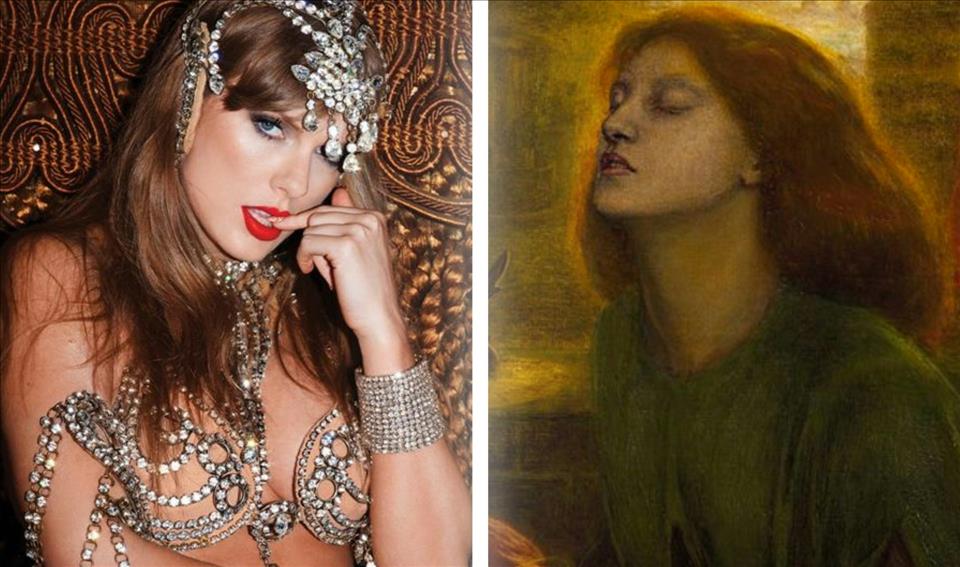
The Pre-Raphaelite Muse Who Inspired Taylor Swift's The Fate Of Ophelia
The painting shows Ophelia, the heroine of Shakespeare's play Hamlet (1623), floating in the river after her doomed relationship had driven her to madness and suicide.
The cover art for The Life of a Showgirl confirms this . It shows Swift wearing a silvery outfit, partially submerged in water with her hands floating palm-up to the surface. So far, so Everett Millais. Though the styling is very different from Millais's work, the pose, with focus on her hands and face, seemed to give a nod to his Ophelia.

Ophelia by John Everett Millais (1851-52). Britain
The model who posed for Millais's painting, Elizabeth Siddal (who is buried in Highgate, near where Swift once lived ) lay in a bathtub while he painted her. When the candles heating the water went out, she stayed there for hours, uncomplaining, until she became ill.
As a muse and model, Siddal exemplifies the woman silenced by and sacrificed to male artistic ambition. Swift's cover transforms the corpse-like Ophelia into a striking image, with her eyes open and staring, as though a dead woman has come back to life to accuse us. The female figure is no longer a muse (or a showgirl).
Siddal was interested in similar themes. In her poem My Lady's Soul, she wrote about a woman transformed through death into art:
The woman in the poem may be silenced, but her eyes accuse us of objectification.
We know Swift is a reader: she's referenced Daphne du Maurier's novel Rebecca , the poet Emily Dickinson , The Great Gatsby and Romeo and Juliet among others, in her music. And the first song on the album, The Fate of Ophelia , references Siddal as well as Shakespeare's tragic heroine.
The song's conceit is that a happy relationship has saved the singer from Ophelia's fate of madness and drowning. Swift has said told interviewers that she prefers a happy ending, having rewritten Romeo and Juliet in Love Story (2008), and The Fate of Ophelia is quite detailed in its references to Hamlet:“The eldest daughter of a nobleman / Ophelia lived in fantasy / But love was a cold bed full of scorpions / The venom stole her sanity.”
The Fate of Ophelia is the first track on Swift's new album, The Life of a Showgirl.
The chorus goes:“All that time / I sat alone in my tower / You were just honing your powers / Now I can see it all. / Late one night / You dug me out of my grave and / Saved my heart from the fate of Ophelia.”
Alone in a tower, waiting for a prince to come? That sounds like some other Shakespearean or pre-Raphaelite heroines, such as Mariana, from Shakespeare's play Measure for Measure (1604) who was reinterpreted by the poet Alfred Tennyson in 1832. painted Mariana in 1851. The speaker in Swift's song, however, has been saved from death:“You dug me out of my grave.”
Elizabeth Siddal (circa 1860).
There are all kinds of interesting resurrection metaphors in the song: was Swift already dead, then? Is this about Ophelia, buried with partial rites due to the suspicion that she killed herself? Or is this about Siddal, the muse and model whose body was exhumed by her husband ?
When Siddal died by overdose of laudanum (an opiate many Victorians were addicted to since it was prescribed for many illnesses) in 1862, she was buried at Highgate cemetery. Her grief-stricken (or guilt-ridden) husband Dante Gabriel Rossetti threw his manuscript poems into her coffin. Seven years later, the coffin was exhumed in order to restore the manuscripts to Rossetti for publication.
The myths exploded from that point. Charles Augustus Howell, the unscrupulous friend of Rossetti who oversaw the exhumation, claimed that Siddel's body was perfectly preserved, her hair had continued growing in her coffin and – as Rossetti wrote to Swinburne in a letter dated October 16 1869 – he believed that“could she have opened the grave, no other hand would have been needed”.
In her reworking of the Ophelia and Siddal story, Swift undermines the stereotype of the mute, decorative showgirl by overlaying it with her own more triumphant ending.
In isolation, Swift's conflation of Siddal, Ophelia and her own persona isn't necessarily that progressive: after all, the song features a woman waiting for someone to save her. However, taken in conjunction with the rest of the album, it's clear that Swift's approach is to explore the public face of women, from Elizabeth Taylor (reminiscent of Clara Bow from her last album) to Eldest Daughter , and culminating in the title track, which indicates the pain behind the facade of a public figure,“hidden by the lipstick and lace”.
Looking for something good? Cut through the noise with a carefully curated selection of the latest releases, live events and exhibitions, straight to your inbox every fortnight, on Fridays. Sign up here .

Legal Disclaimer:
MENAFN provides the
information “as is” without warranty of any kind. We do not accept
any responsibility or liability for the accuracy, content, images,
videos, licenses, completeness, legality, or reliability of the information
contained in this article. If you have any complaints or copyright
issues related to this article, kindly contact the provider above.
Most popular stories
Market Research

- Financewire And Tipranks Partner To Redefine Financial News Distribution
- Ethereum-Based Defi Crypto Mutuum Finance (MUTM) Reaches 50% Completion In Phase 6
- Stonehaven Circle Marks 13Th Anniversary With Hadrian Colwyn Leading Calvio Ailegacyx Innovation
- Citadel Launches Suiball, The First Sui-Native Hardware Wallet
- Motif AI Enters Phase Two Of Its Growth Cycle
- Dubai At The Centre Of Global Finance: Forex Expo 2025 Redefines The Trading Landscape



















Comments
No comment